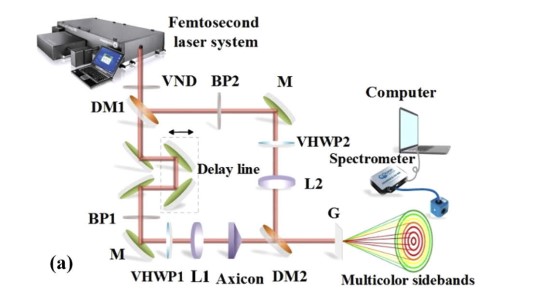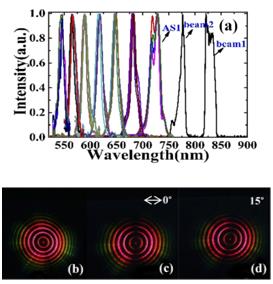Ultrafast vector beams have wide applications in photochemistry, biology and physics. They can be used in pump-probe experiments, high-resolution imaging, manipulating microparticles, classical optical communications and quantum optical communications.
Despite many methods of generating useful vector beams, it is usually not easy for traditional three-wave mixing or second-order nonlinear processes, where an anisotropic nonlinear material is used; and this process is rigidly constrained by phase matching condition which is extremely sensitive to light polarization. Also, it is rather difficult and complex to generate broad bandwidth inhomogeneous distribution in every polarization using one nonlinear crystal.
Therefore, using compact and economical setup by a nonlinear process, especially third-order nonlinear process, how to generate multiple vector beams with different central wavelengths in a broad spectral range remains to be an unexplored issue.
Recently, researchers at Shanghai Institute of Optics and Fine Mechanics, Chinese Academy of Sciences, generated novel multicolor concentric annular ultrafast vector beams (MUCAU-VB) based on cascaded four-wave mixing (CFWM) process simply in a glass plate and realized the modulations of a laser beam in spatial mode, polarization, wavelength, and pulse duration simultaneously. The result was published in Optics Express.
In the experiment, two radially polarized pump beams modulated by two vortex half-wave plates were used to pump the glass plate. When the two beams were overlapped both in spatial and temporal domain, concentric annular beams with radial polarization, multicolor sidebands in a broad spectral range, and femtosecond pulse duration were demonstrated.
Up to 10 radially polarized frequency-upconversion concentric annular sidebands with wide bandwidth were observed. Researchers found that the spectral range of the first 7 order could extend from 545 nm to 725 nm and the pulse duration of the first-order sideband was measured to be 74 fs.
This method can be used to generate other polarization state and other spectrum range vector beams. And it would benefit further generation and applications of multicolor ultrafast vector beams.
The work was supported by National Natural Science Foundation of China; the Instrument Developing Project and the Strategic Priority Research Program of the Chinese Academy of Sciences;

Fig. 1. Experimental setup. (Image by SIOM)
Fig. 2. (a) Spectra of the sidebands. (b) Photographs of the generated multicolor sidebands. (c) and (d) Photographs of the multicolor sidebands. (Image by SIOM)
Article website:
https://doi.org/10.1364/OE.387821
Contact:
Mr. CAO Yong
General Administrative Office
Shanghai Institute of Optics and Fine Mechanics, CAS
Email: caoyong@siom.ac.cn